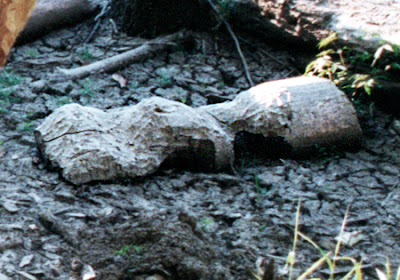 pictograph / petroglyph? / whatever - S.W. Washington - April 2004
pictograph / petroglyph? / whatever - S.W. Washington - April 2004
The ability to use these physical attributes is even more recent so that language and speech and the propensity toward symbolic thought can really only be thought of as new evolutionary experiments.
Even so, metaphorical or symbolic thinking does seem to go hand in hand with a level of consciousness that appears to transcend common animal existence. Consequently vast segments of humanity have been led to posit an additional, supernatural, god granted element (often referred to as the soul) associated with the human body. No other animal builds complex cultures and civilizations and therefore it is reasoned that humans must hold a position at the apex of evolution/creation. This assumption is often suggested in humanity’s sacred writings.
 Renegade Cows - Mt. Adams - S.W. Washington - Sept. 2007
Renegade Cows - Mt. Adams - S.W. Washington - Sept. 2007
Ironically, one of the benefits to owning a soul is that it makes it easier to justify eating animals that don’t have souls.
Willamette Falls @ Oregon City - Jan. 2006 (Click on the image to view a somewhat larger version)
We like to point to our technology as evidence for the power of our big brains, but don’t quite grasp that the end result is no better and often worse than what other animals accomplish with instinct.
 Beaver dam @ Bybee Lake - Northwest Oregon - (Click on the image to view a somewhat larger version)
Beaver dam @ Bybee Lake - Northwest Oregon - (Click on the image to view a somewhat larger version)
Beaver construction projects actually turn out to be beneficial to life.
 For little mammals with no obvious language skills, beavers have an extraordinary list of engineering accomplishments. This dam is the first in a series of dams or locks that shape one of the inlets to Bybee Lake. This dam apparently controls the water level around the beaver’s home lodge (located in the upper right hand corner of the photo).
For little mammals with no obvious language skills, beavers have an extraordinary list of engineering accomplishments. This dam is the first in a series of dams or locks that shape one of the inlets to Bybee Lake. This dam apparently controls the water level around the beaver’s home lodge (located in the upper right hand corner of the photo).
Below the dam, additional locks and secondary dams control the seasonal variation of water levels. Massive beaver dredging projects maintain an open channel to the lake, even in the summer.
Beaver construction techniques utilize wood acquired from their extensive lumberjack operations as well as local mud and clay.
Beaver canal to the open lake.
Back door to beaver lodge.

Underwater tunnel system exposed.
Tree harvesting.
Distribution of resources - overland and overwater.
Beaver infrastructure
It all raises a question. If a beaver can build homes, dams, locks, roads, tunnels and canals – if a beaver can harvest and transport timber – if a beaver can plan ahead and store food for the winter – if a beaver can safeguard his family from predators – how is it that a beaver isn’t actually conscious?
Maybe consciousness like our own is only a matter of degree – and not the divine impartation of a magical element.
Here we might see evidence for a developing sculptural sensibility.
The resemblance between this unfinished beaver sculpture…
…and this famous Egyptian sculpture is remarkable.

Possible beaver-made duck decoy.
In Stanley Kubrick’s movie, 2001: A Space Odyssey, a mysterious black monolith teaches a band of hominids to use tools. One of the hominids throws a bone ‘smashing implement’ into the air. The bone twirls up into the sky where it gradually morphs into a space craft. The whole technical evolution of our species is implied during the artful passage of a few seconds of celluloid.
Perhaps here in a similar fashion, on the bank of Bybee Lake, these implements mark the birthplace of beaver consciousness…
…as they struggle to come to grips with the ‘lever principle’.
Is this an example of beaver engineers using levers to raise rock obstructions out of their navigable canals?

Is this a beaver traffic signal?

Is this a beaver rendering of James Dean?
Only time will tell.





























No comments:
Post a Comment